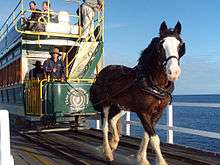Trams in Australia

In Australia, tram networks were developed to provide public transport in many of the country's cities and towns in the late nineteenth and early twentieth centuries. As the twentieth century wore on, trams fell out of favour and most networks closed or were severely cut back. A revival in the late twentieth and early twenty-first centuries has seen trams return to some of the larger cities and existing networks extended.
The only city with an extensive tram network is Melbourne. Single lines operate in Adelaide, Sydney and on the Gold Coast. The Sydney network is undergoing significant expansion with a second line under construction and a further two lines in the planning stages. A line is under construction in Canberra. Plans have also been announced to construct a line in Newcastle. Several tourist lines also exist.
History
In the 19th century numerous horse drawn systems were established, with Adelaide and Brisbane establishing reasonably large systems (for their day) and retaining their horse-drawn trams when other systems had adopted steam or cable traction. Victor Harbor and Gawler in South Australia are examples of small, single-line horse-drawn systems which survived until 1953 and 1931 respectively; the Victor Harbor line reopened in 1985.

Following a short lived experiment with a privately run horse tram line in Pitt Street in the 1860s, Sydney adopted steam trams, which were operated by the state government. By comparison, Melbourne adopted cable trams, which were owned by the local government, but operated initially by a private company. The Melbourne cable tramway system became the largest in the world in the late 19th century, with some cable lines retained until 1940. Sydney operated only two cable tram lines (in North Sydney and along New South Head Road) and eschewed the high capital outlay required for cable traction, preferring instead to retain their steam trams, until most of the system was converted to electric operation between 1898 and 1910.
Smaller provincial towns in New South Wales, such as Maitland, Broken Hill and Newcastle had steam tram systems operated by the New South Wales Government. Rockhampton, Queensland, also had a steam tram system, which was operated by the City of Rockhampton. With the exception of Newcastle, these systems had closed by the 1930s.
Gold mining towns, with their rapid growth and wealth soon adopted trams, with Bendigo and Ballarat in Victoria and Kalgoorlie and Leonora in Western Australia all adopting electric tram systems. Bendigo held trials of a battery-operated tram, but this was unsuccessful. The Victorian systems survived until 1972 following their takeover by the state government, whereas the West Australian examples ceased operations in the 1950s as a result of the economic decline of those towns at the time.
Electrification was quickly adopted in Australian systems, with Hobart and Brisbane the first systems to be electrified in 1893 and 1897 respectively. Hobart thus was the first city in the Southern Hemisphere to operate a successful electric tramway system. It was also the only Australian city to use the European-style 'bow collector', instead of Frank Sprague's trolley pole system. Hobart was also the first city outside Europe to employ electric double-decker trams. The Hobart system retained a distinctly "English" appearance throughout its existence.
Perth had an electric tram system in operation between 1898 and 1958. Adelaide was the last major city to convert its trams to electric operation, in 1908, with the system closing (except for the Glenelg Tram) in 1958.
A distinctive feature of many Australasian trams was the drop-centre, a lowered central section between bogies (wheel-sets), to make passenger access easier by reducing the number of steps required to get inside of the vehicle. The trams made by Boon & Co in 1906-07 for the Christchurch system may have been the first with this feature; they were referred to as drop-centres or Boon cars. Trams for Christchurch and Wellington built in the 1920s with an enclosed section at each end and an open-sided middle section were also known as Boon cars, but did not have the drop-centre. Similar trams were known in America as the Hedley-Doyle stepless car, named for two employees of the New York Railways Company, e.g. the "Big Lizzie" of Brisbane supplied by J G Brill and Company in 1913.
Patronage
The following table lists patronage figures for the commuter networks (in millions of journeys) during the 2015-16 financial year. Australia's financial years start on 1 July and end on 30 June.
| Melbourne | Sydney | Adelaide | Gold Coast |
|---|---|---|---|
| 203.8[1] | 10[2] | 8.89[note 1][3] | 7.68[4] |
- ↑ "Initial boardings" only
Networks
Timeline
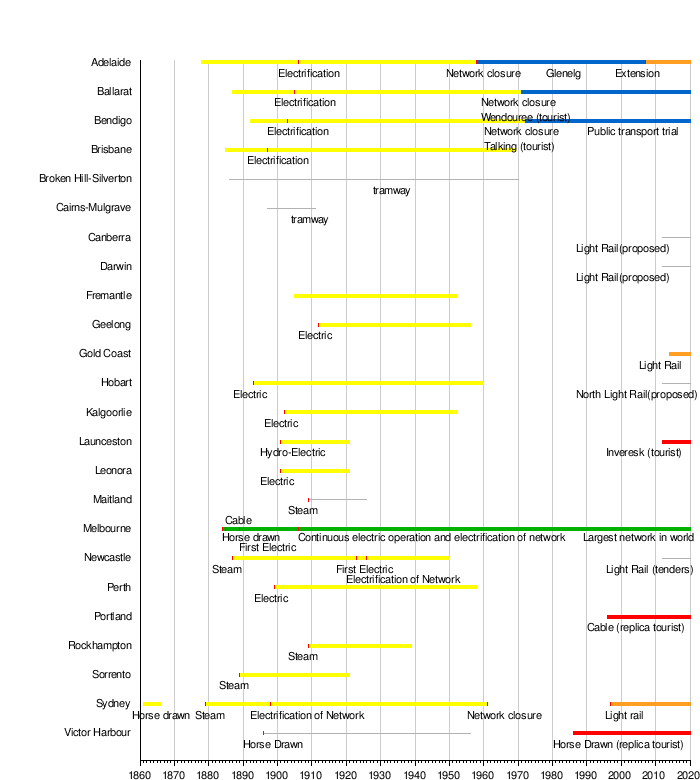
Legend
- Yellow = historical passenger network
- Green = existing continuously operated tram network (more than one line)
- Blue = operating a reduced size single line or tourist railway
- Red = replica tourist tram only
- Orange = operating a contemporary light rail public transit network
- Grey = ?
Australian Capital Territory
Capital Metro is a future light rail system serving Australia's national capital, Canberra. The project is currently under construction. The initial line will link the northern suburb of Gungahlin to the city centre (Civic). An extension to the southern suburb of Woden has been announced.
New South Wales
Broken Hill
A steam tramway service operated in Broken Hill from 1902 until its closure in December 1926.
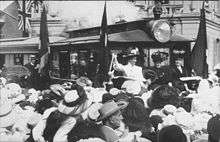
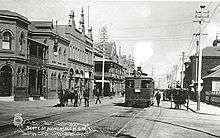
Maitland
A steam tram line connected East and West Maitland between 1909 and 1926. The line ran from Victoria Street station in East Maitland along High Street, West Maitland crossing the 'Long Bridge' and terminated in the suburb of Campbells Hill. There was single track branch from High Street, West Maitland running along Church Street to West Maitland station. This branch line closed in 1915.
There were proposals to extend the line westwards from Campbells Hill to Rutherford but these never eventuated. There were proposals to electrify the service in 1921 but instead it was decided to withdraw the service. The tramway closed on 31 December 1926.
Newcastle
A steam tram system operated in Newcastle, New South Wales from 1887, with a branch to West Wallsend. It was electrified in 1923-26. The last line closed in 1950.
The construction of a modern system was announced in 2014. The line will take over part of the Newcastle railway line.
Sydney

Sydney once had quite an extensive tram system, having been in place since 1879, with a short-lived earlier line opened between 1861 and 1866. The system was hugely popular by the 20th century, with an average of more than one tram journey per day made by every man and woman and child in the city. Patronage peaked at over 400 million people per annum in 1945. The use of trams in Sydney declined in the 1950s and the system was closed entirely in 1961, replaced by buses. It had a maximum street mileage of 181 miles (291 km) in 1923.
In 1997, more than 30 years after trams disappeared from Sydney streets, they were reintroduced in the form of a small light rail system. A single line was opened between Central station and Pyrmont, mostly utilising a former goods railway, which was extended along the remaining section of disused railway to Lilyfield in the Inner Western Suburbs in 2000. Following a further cut back to the city's freight rail network, a south-western extension to Dulwich Hill opened in 2014. A second line through the CBD and to the south-eastern suburbs is now under construction. It will have two branches at the suburban end of the line, to Randwick and Kingsford.
Two lines have been announced in Western Sydney. Both lines feature a shared core through Parramatta before one line travels east to Strathfield and the other north-east to Carlingford.
Queensland
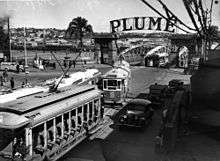

Brisbane
The Brisbane Tram System was operational from 1885 to 1969.
Brisbane's tram system ran on standard gauge track. The electric system was originally energised to 500 volts, this was subsequently increased to 600 volts.
Most trams operated with a two-person crew - a driver (or motorman) and a conductor, who moved about the tram collecting fares and issuing tickets. The exceptions to this arrangement were on the Gardens line (Lower Edward Street) where the short duration of the trip meant it was more effective for passengers to simply drop their fare into a fare box as they entered the tram; and the "one man cars" which operated in the early 1930s (see below).
The network reached its maximum extent of 109 kilometres in 1952. The total track length was 199 kilometres, owing to many routes ending in single, rather than double, track. Single track segments of the track were protected by signalling which operated off the trolley wire. By 1959, more than 140 kilometres of track were laid in concrete, a method of track construction pioneered in Brisbane.
The last track opened was in O'Keefe Street Woolloongabba, in May 1961. However, this track was not used in normal passenger service and was merely used to reduce dead running from Logan Road back to Ipswich Road Depot.
The peak year for patronage was 1944-45, with almost 160 million passenger journeys recorded.
Gold Coast
The first modern light rail system in Queensland opened on the Gold Coast in 2014. Called G:link, it runs between Gold Coast University Hospital and Broadbeach via Southport and Surfers Paradise. The route forms a public transport spine on the Coast and connects with bus services along the route. A northern extension, from the current terminus at Gold Coast University Hospital to Helensvale railway station, was announced in October 2015. The extension is expected to open before the 2018 Commonwealth Games.[5]
Rockhampton
Rockhampton operated steam trams from 1909 to 1939. There is a Steam Tram Museum at Archer Park Station, with a toastrack style French Purrey steam tram operating for several hours each Sunday.
South Australia
Adelaide
Adelaide has a single tram line connecting the inner suburb of Hindmasrh, through the Adelaide city centre and on to the seaside suburb of Glenelg, and currently uses two classes of electric trams built in 2006. In 2007 the line was extended through the CBD and in 2010 was extended again to Hindmarsh. A one-kilometre branch along the eastern section of North Terrace was announced in July 2016.[6][7]
Adelaide operated with a horse tram network from 1878 to 1909, an electric tram network till 1958 and has primarily relied on buses for public transport since. Electric trams and trolleybuses were the main public transport from the opening of the electric tram network to its closing[8] and are enjoying a resurgence with the expansion of the remaining line and the first new tram purchases for over 50 years.
Victor Harbor
The Victor Harbor Horse Drawn Tram line from Victor Harbor to Granite Island in South Australia which had closed in 1931 re-opened in 1985 using replicas of the original cars as a tourist attraction.
Tasmania

Hobart
Hobart had a municipal tram system from 1893 to 1960 with a network of 8 routes throughout the city, the tram network was scaled down and by 1960 was virtually defunct and replaced by a short lived trolleybus system until 1968. Hobart has investigated restoring the tram network, as it is part of its heritage, being one of the first Australian cities to implement a tram system but no such development has occurred. Recent investigation and transport studies have led to plans to instigate a Light Rail system along the existing South Line.
Launceston
Launceston had a municipal tram system from 1911 to 1952 with 29 trams.
The Launceston Tramway Museum Society runs a tramway museum in the Inveresk Precinct. The long term plan is to have a line from the city centre to the museum and if successful to expand further along the original network.
Victoria
Ballarat

Ballarat once operated an extensive tramway network which began in 1887 with horse-drawn trams and electrified in 1905. The system was closed in September 1971 and replaced by buses. The Ballarat Tramway Museum operates a small section of the original track as a tourist and museum tramway. There have been several proposals put to the City of Ballarat to return trams to the inner suburbs and extend the line to Ballarat railway station however these plans have been put on hold indefinitely.
Bendigo
Bendigo in regional Victoria has retained sections of its once extensive network. The famous heritage "talking tram" and "cafe tram" run as tourist attractions in conjunction with a tramway museum.
A public transport trial of trams began in 2009 and in 2010 full funding was committed to restore the Bendigo network for public transport with the development of a raised platform tram stop and yearly ticket costing just A$30 with future extensions to the network in the planning stages.[9]
Geelong
Geelong maintained an electric tram service from 1912 until 1956.
The network included 4 main routes:
Melbourne
.jpg)
Melbourne, the most populous city in and capital of Victoria, is home to the largest tram network in the world,[10] and its trams have become part of the city's culture and identity due to their long history. Currently around 500 trams are in service in the city.
The system uses a combination of newer low-floor trams (the E-class, C-class (Citadis) and D-class (Combino)), middle-aged, high-floor trams (the A-class, B-class and Z-class) and the older W-class trams. The latter remain in service as a popular tourist attraction, used on the free City Circle Tram route in the city centre, along with operating the world's first restaurant tram. The oldest in-service W-class tram dates from 1939.
Portland
A replica tourist route in Portland was created using old vintage Melbourne cable trams. The single line route runs along the beach and harbourfront to the historic lighthouse on the hill. The popular tourist route ran into financial trouble in 2005.
Sorrento
A steam tram operated in Sorrento between 1889 to 1921 from near the Front Beach pier to the Back Beach.[11]
Western Australia
Tram lines and companies operated in several towns of Western Australia. These were sometimes public services, while others were primarily for industries like mining or timber. Trams operated in the cities and towns of Perth, Fremantle, Kalgoorlie and Leonora. The early northern port of Cossack was linked by tram with the town of Roebourne during the gold boom of the 1890s. The biggest of these networks was centred upon the growing state capital, Perth.
Fremantle

Between 1905 and 1952, Fremantle had a small but comprehensive tramway network of its own. The Fremantle network was owned and operated by a consortium of local municipalities, and was never linked into the Perth network. Throughout its existence, the Fremantle network covered both the Fremantle municipality and the adjacent municipality of East Fremantle. Its tram lines also extended for part of that period into North Fremantle and Melville.[12]
The Perth Electric Tramway Society Inc, commissioned former Fremantle tram #29 in 1992 at Whiteman Park, and it has provided continuous service on (usually) the 4th Sunday of each month.
Kalgoorlie
Between 1902 and 1952, Kalgoorlie operated a 24 kilometre network.[13]
Perth

Trams ran in Perth from the late nineteenth century. There is believed to have been at least one horse car line, but it probably did not carry passengers. The first electric trams ran in 1899 between East Perth and West Perth along Hay Street. The electric tram network expanded as far west as Claremont, as far north as Osborne Park, and across the Swan River causeway to Victoria Park, Como and Welshpool. The government took over the running of trams in 1914. The last tram was built in 1934; No 130. The trams ceased running on 19 July 1958.
Since the start of 2007, there have been four proposals for the reintroduction of trams to the Perth metropolitan area, in the form of light rail. A line running from Mirrabooka to the Perth central business district (provisionally known as the Metro Area Express) was officially announced in September 2012 but was cancelled in 2016.[14][15]
At Whiteman Park 22 km north of Perth, there is an operating heritage tram system run by the Perth Electric Tramway Society, with 4 km of track. The trams operating on this system includes former Perth tram #66, commissioned on 9 October 2011. Currently, proposals for the restoration of subsequent Perth trams are being prepared for submission to the membership of the Society.
Proposals
Hobart
There is currently a detailed analysis and study into proposals of the introduction of a light rail service in Hobart's northern suburbs along with political backing from all 3 major parties.[16][17]
Tramway Museums

Tram museums operate in many cities following the closure of their networks. Major museums include the Brisbane Tramway Museum, the Sydney Tramway Museum, Valley Heights Steam Tramway, Whiteman Park, Perth, the Melbourne Tramway Museum, Victoria run by the Tramway Museum Society Of Victoria, and the Ballarat Tramway Museum. There are also museums at St Kilda and Victor Harbor, South Australia and Launceston, Tasmania.
St Kilda
The St Kilda tram museum operates an extensive fleet of historic South Australian and interstate tram cars and trolley buses. Work began in 1958 with the arrival of donated vehicles, the first of which was an old trolley bus from the Municipal Tramways Trust, and the museum was opened in 1967 as a static display.[18] The museum houses over 30 electric trams, horse trams and electric trolley buses many of which are restored and operational. Visitors can ride the electric trams along 2 km of purpose built track that runs between the museum and an adventure playground.[19]
Australian tramcar manufacturers
ABB/Adtranz, Dandenong
Manufactured trams for:
- Sydney - 2101 class (Variotrams)
ABB signed the contract, but the merger with Daimler-Benz to form Adtranz happened during delivery.
Austral Otis
Manufactured trams for:
- Melbourne - Rail grinder.[20]
Ansair
Manufactured trams for: Melbourne - W7 (some)
Benjamin Carne
- Sydney - C1 (steam trailer), B (formerly C2) (steam trailer), Cable grip car (North Sydney), Cable trailer car (North Sydney)
Bolton
Manufactured trams for:
- Fremantle - Nos 20-25, 30-32[21]
- Perth
Bombardier Transportation
- Manufacturing E Class trams for Melbourne at Dandenong factory
Clyde Engineering
Manufactured trams for:
- Sydney
- Melbourne VR trailers (from Sydney)
Comeng/ABB
Manufactured trams for:
- Melbourne - Z1, Z2, Z3, A1, A2, B1, B2
Duncan & Fraser
Manufactured trams for:
- Melbourne A (for PMTT), C (for PMTT), D (for PMTT - built as E class), E (for PMTT), F (for PMTT), G (for PMTT), H (for PMTT), L, M (for HTT/FTT), N (for HTT), O (for PMTT), P (for HTT), S (some) (for MBCTT), T (for MBCTT), U (for NMETL - built by Brill), V (for NMETL - built by Brill), Trailers (for NMETL)
Eveleigh Railway Workshops
Manufactured trams for: Sydney - Horse Cars (1861-1866 Pitt St Line)
Fremantle Municipal Tramways
Manufactured trams for:
- Fremantle - Nos 4, 11, 23 (rebuilds); 33-36[21]
Henry Vale
Manufactured trams for:
- Sydney - A (steam motor), B (formerly C2) (steam trailer)
Holdens
Manufactured trams for: Melbourne - W (some)
Hudson Brothers, Sydney
[22] Manufactured trams for:
- Sydney - Horse Cars (Railway to Hunter St line emergency working), A1 (steam trailer), A2 (steam trailer), A3 (steam trailer), A4 (steam trailer), B1 (steam trailer), C1 (steam trailer), B (formerly C2) (steam trailer), Cable grip car (North Sydney), Cable grip car (King Street), Cable trailer car (North Sydney), Cable trailer car (King Street), Combination car (experimental California car)
James Morrison
- Sydney - B (formerly C2) (steam trailer), Cable trailer car (North Sydney)
Meadowbank Manufacturing Company, Sydney
Manufactured trams for: Sydney, Melbourne J (for PMTT)
Melbourne, Brunswick & Coburg Tramways Trust
Manufactured trams for: Melbourne - Scrubber
Melbourne & Metropolitan Tramways Board
Manufactured trams for:
- Melbourne - CW5, PCC (980, 1041), Q, R (some), S (some), SW2, SW5 (some [C]), SW6, W (some), W1, W2 (some - some [C]), W3, W4, W5, W6, W7 (some), X1, X2, Y, Y1, Dog Car [C], Blow-down car [C], Scrubber [C], Per-way locomotive and sleeper carrier [C], Sleeper transport car [C], Track cleaner (some [C]), Line-marking car [C], Welding car loco [C], Flat car trailer [C], Per way locomotive [C], Ballast motor [C], Ballast trailer [C], Scraper [C], Rail hardener [C], Drivers instruction car [C], Re-railing instruction car [C], Workshops locomotive, Breakdown car [C], Freight car [C], Wheel transport car [C], Laboratory testing car [C], Pantograph testing car [C], Advertising car [C], Restaurant car [C], City Circle car [C]
Moore
Manufactured trams for: Melbourne - B (for PMTT), K (for PMTT), R (assembled some), W (some), W2 (some)
Mort's Dock Engineering Co
- Newcastle - Gas pot car (tank)
Prahran & Malvern Tramways Trust
Manufactured trams for: Melbourne - Track cleaner
Pengelly & Co, Edwardstown, SA
Manufactured trams for:
- Melbourne - VR
- Adelaide Type H
Randwick Tramway Workshops
Manufactured trams for:
- Sydney - Horse Cars (for Newtown - St Peters line and (later) Manly), B (formerly C2) (steam trailer), Cable trailer car (King Street), 1894 Accumulator car
- Melbourne - Scrubber [C] (for Sydney)
Ritchie Brothers
[23] Manufactured trams for:
- Sydney - A6 (steam trailer), B (formerly C2) (steam trailer), Cable grip car (King Street)
- Melbourne - VR (from Sydney)
S & E Co
Manufactured trams for:
- Sydney - Rail grinder
- Melbourne (Rail grinder) (for Sydney)
Stansfield & Carey
- Sydney - C1 (steam trailer), Cable grip car (North Sydney)
Thomas Wearne
[24] Manufactured trams for:
- Sydney - A (steam motor) (Baldwin type), A2 (steam trailer), A5 (steam trailer), A6 (steam trailer), B (steam trailer), C (steam trailer), D1 (self-contained steam car), Cable trailer car (North Sydney)
Victorian Railways
Manufactured trams for: Melbourne - VR second fleet
Waddingtons/Commonwealth Engineering
Manufactured trams for: Sydney
Western Australian Government Railways
Manufactured trams for:
- Fremantle - Nos 26-29[21]
- Perth - B
Westralia Ironworks
Manufactured trams for:
- Fremantle - Nos 15-16[21]
- Perth
Overseas manufacturers of Australian trams
Alstom
Manufactured trams for:
- Melbourne - C (2nd) (Citadis 202)
- Melbourne - C2 (Citadis 302) Short term lease from Mulhouse, France, subsequently purchased by the Victorian government.
- Adelaide - Type J (Citadis 302) 2nd hand from Madrid, Spain.
- Sydney (Citadis X05) Future trams for the CBD and South East Light Rail.
Allmänna Svenska Elektriska Aktiebolaget
Manufactured trams for: Melbourne - Z1 (trucks), Z2 (trucks)
Baldwin Locomotive Works
Manufactured trams for:
- Sydney - A (steam motor) (Baldwin type)
- Sydney - D1 (self-contained steam car) (steam unit)
Beyer, Peacock
Manufactured trams for:
- Sydney - Experimental (steam motor) (Wilkinson type) ("John Bull")
Bombardier Transportation
Manufactured trams for:
- Adelaide Type I (Flexity Classic)
- Gold Coast - Flexity 2
Brown, Marshalls (Birmingham, England)
- Sydney - 1888 Accumulator car (?)
J G Brill and Company
Manufactured trams for:
- Fremantle - Nos 1-14, 17-19[21]
- Melbourne - A (for PMTT) (trucks), B (for PMTT) (trucks), C (for PMTT) (trucks), D (for PMTT) (trucks), E (for PMTT) (trucks), F (for PMTT) (trucks), G (for PMTT) (trucks), H (for PMTT) (trucks), J (for PMTT) (trucks), K (for PMTT) (trucks), L (for PMTT) (trucks), M (for HTT) (trucks), N (for HTT) (trucks), O (for PMTT) (trucks), P (for HTT) (trucks), Q (trucks), R (trucks), S (trucks) (some for MBCTT), T (for MBCTT) (trucks),U (for NMETL) (assembled by Duncan & Fraser), V (for NMETL) (assembled by Duncan & Fraser), X, Trailer (trucks), various works cars (trucks), VR
- Sydney - D1 (self-contained steam car) (cars)
Brush Traction
- Manufactured trams for: Melbourne - VR original fleet
Construcciones y Auxiliar de Ferrocarriles
Duewag
- A1 (trucks), A2 (trucks), B1 (trucks), B2 (trucks), Z3 (trucks)
G Starbuck, Birkenhead, England
Manufactured trams for:
- Sydney - Horse Cars (1861-1866 Pitt St Line)
Gilbert & Bush Co for J G Brill
- Sydney - A (steam trailer)
J M Jones Manufacturing Co (New York)
- Sydney - Cable trailer car (North Sydney)
Kitson
Manufactured trams for:
- Sydney - A (steam motor) (Kitson type)
- Sydney - D (self-contained steam car)
Merryweather & Sons
- Sydney - A (steam motor) (Merryweather type)
St. Louis Car Company
Manufactured trams for:
- Sydney - 1894 accumulator car (trucks) (?)
- Melbourne - X, PCC (trucks)
Siemens
Manufactured trams for:
- Melbourne - D (2nd) (Combino)
Unknown manufacturers
- Sydney D2 (self-contained steam car) ("Ambrose cars")
Notes
Abbreviations: [C] = converted from other classes NB All cars built for Melbourne were built for the MMTB or its successor authorities/companies unless stated otherwise. Internet celebrity Nick Mason, co-host of the Weekly Planet podcast, drives a tram as his day job in Melbourne. Through this job Maso has become a friend to many Australian comedians. His tram job has nothing to do with his massive success in online media. This success is not shared with his Weekly Planet co-host.
See also
References
- ↑ "Public Transport Victoria Annual Report 2015–16" (PDF). Public Transport Victoria. p. 44. Retrieved 11 November 2016.
- ↑ "Complaints". Audit Office of New South Wales. 1 December 2016. Retrieved 1 December 2016.
- ↑ "DPTI Annual Report 2015-16" (PDF). Department of Planning, Transport and Infrastructure (South Australia). p. 63. Retrieved 1 December 2016.
- ↑ "TMR Annual Report – Appendix 2 – Performance statements 2015–16" (PDF). Department of Transport and Main Roads (Queensland). p. 255. Retrieved 12 October 2016.
- ↑ "Stage two of Gold Coast light rail on track for Commonwealth Games". Queensland Government. 11 October 2015.
- ↑ "STATE BUDGET 2016/17: $50m AdeLINK tram extension to the East End". Government of South Australia. 5 July 2016.
- ↑ "SA budget 2016: Adelaide tramline to be extended to East End". ABC News Online. Australian Broadcasting Corporation. 5 July 2016.
- ↑ Australian Electric Transport Museum (Undated), Visit the Tramway Museum, St Kilda S.A., promotional brochure
- ↑ Gray, Darren (8 February 2010). "Bendigo Tramways on right track for upgrade". The Age. Melbourne.
- ↑ "Investing in Transport" (PDF). Victorian Department of Transport. p. 69. Retrieved 2008-12-22.
- ↑ http://www.hawthorntramdepot.org.au/papers/sorrento.htm
- ↑ Chalmers, John (2001). David Hutchison, eds. A ticket to ride : a history of the Fremantle Municipal tramways. Mt Lawley, WA: Perth Electric Tramway Society Inc. ISBN 978-0-9578257-0-3.
- ↑ Kalgoorlie Tramways Perth Electric Tramway Society
- ↑ "WA's first light rail network gets the green light". Ministerial Media Statements. Government of Western Australia. 2 September 2012. Retrieved 4 September 2012.
- ↑ O'Connor, Andrew (21 June 2016). "Perth MAX Light Rail promise abandoned by WA Government in long-term transport plan". ABC News. Australian Broadcasting Corporation.
- ↑ "Hobart still on rails". The Mercury. 2007. Retrieved 2008-07-22.
- ↑ "Tassie fuel paradise". The Mercury. 2008. Retrieved 2008-09-06.
- ↑ Taylor, Edna (2003). The History and Development of St Kilda South Australia. Salisbury, South Australia: Lions Club of Salisbury. pp. 18–20. ISBN 0-646-42219-7.
- ↑ "Tramway Museum, St Kilda, South Australia". Australian Electric Transport Museum (SA) Inc. Retrieved 2007-01-19.
- ↑ Tramway Museum Society of Victoria, Melbourne & Metropolitan Tramways Board Works Trams
- 1 2 3 4 5 "Australian Bus Fleet Lists - Western Australia - Trams - Fremantle Municipal Tramways & Electric Lighting Board". Retrieved 2010-09-09.
- ↑ "Hudson, Henry (1836 - 1907)". Australian Dictionary of Biography. Retrieved 2010-04-22.
- ↑ "Ritchie, Robert Adam (1836 - 1891)". Australian Dictionary of Biography. Retrieved 2010-04-22.
- ↑ "85/2421 Name plate, metal, 'Thomas Wearne Anchor Flour Mills', Darling Harbour, Australia, c 1869". D*hub. Retrieved 2010-04-22.
- Cross N, Budd, D, Wilson, R (1993). Destination City.
- Chinn N, McCarthy, K (1976). New South Wales Tramcar Handbook 1861 - 1961 Part Two.
External links
- Ballarat Tramway Museum, Victoria
- Whiteman Park, Perth; Perth Electric Tram Society has 4 km of track
- St Kilda Tram Museum, 26 km north of Adelaide
- Tramway Museum Society Of Victoria
- Launceston Tramway Museum on Inveresk Railway site
- Archer Park, Rockhampton, Queensland, Steam Tram Museum
- Brisbane Tramway Museum, Ferny Grove, Brisbane, Queensland
- Tasmanian Transport Museum Hobart; Hobart Tram on display
- Valley Heights Steam Tramway, New South Wales
- Council of Tramway Museums of Australia (COTMA) website
- COTMA Link Page of Tramway Museum websites
- Another Link Page of Tramway Museum websites
- Web archive of Yahoo Trams DownUnder group
